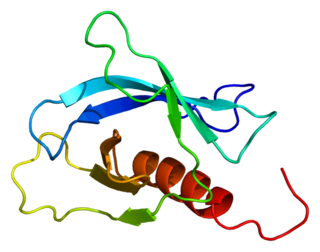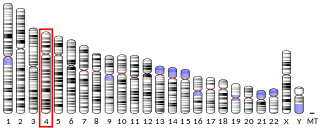
Bardet–Biedl syndrome (BBS) is a ciliopathic human genetic disorder that produces many effects and affects many body systems. It is characterized by rod/cone dystrophy, polydactyly, central obesity, hypogonadism, and kidney dysfunction in some cases. Historically, slower mental processing has also been considered a principal symptom but is now not regarded as such.

Linker for activation of T-cells family member 2 is a protein that in humans is encoded by the LAT2 gene.

40S ribosomal protein S4, Y isoform 1 is a protein that in humans is encoded by the RPS4Y1 gene.

McKusick–Kaufman/Bardet–Biedl syndromes putative chaperonin is a protein that in humans is encoded by the MKKS gene.

Bardet–Biedl syndrome 1 protein is a protein that in humans is encoded by the BBS1 gene. BBS1 is part of the BBSome complex, which required for ciliogenesis. Mutations in this gene have been observed in patients with the major form of Bardet–Biedl syndrome.

Bardet–Biedl syndrome 5 protein is a protein that in humans is encoded by the BBS5 gene.

ADP-ribosylation factor-like protein 6 is a protein that in humans is encoded by the ARL6 gene.

Bardet–Biedl syndrome 2 protein is a protein that in humans is encoded by the BBS2 gene.

Bardet–Biedl syndrome 4 is a protein that in humans is encoded by the BBS4 gene.

Tripartite motif-containing protein 32 is a protein that in humans is encoded by the TRIM32 gene. Since its discovery in 1995, TRIM32 has been shown to be implicated in a number of diverse biological pathways.

Dymeclin is a protein that in humans is encoded by the DYM gene.

FYVE, RhoGEF and PH domain-containing protein 3 is a protein that in humans is encoded by the FGD3 gene.

Zinc finger protein 330 is a protein that in humans is encoded by the ZNF330 gene.

Coiled-coil domain-containing protein 28B is a protein that in humans is encoded by the CCDC28B gene.

Tetratricopeptide repeat domain 8 (TTC8) also known as Bardet–Biedl syndrome 8 is a protein that in humans is encoded by the TTC8 gene.

Bardet–Biedl syndrome 7 is a protein that in humans is encoded by the BBS7 gene.

Bardet–Biedl syndrome 9 is a protein that in humans is encoded by the BBS9 gene.

Bardet–Biedl syndrome 12 is a protein that in humans is encoded by the BBS12 gene.

Meckel syndrome, type 1 also known as MKS1 is a protein that in humans is encoded by the MKS1 gene.
The BBSome is an octameric protein complex. It is a component of the basal body and is involved in trafficking cargos to the primary cilium. The BBSome is a complex of seven Bardet–Biedl syndrome (BBS) proteins: BBS1, BBS2, BBS4, BBS5, BBS7, BBS8 and BBS9. In addition the BBSome contains the BBIP10 protein. Mutation in each of this eight BBSome genes causes a severe multiorganic syndrome (BBS) presenting in most cases by retinal dystrophy, obesity, renal anomalies, post-axial polydactyly, and developmental delay.




















